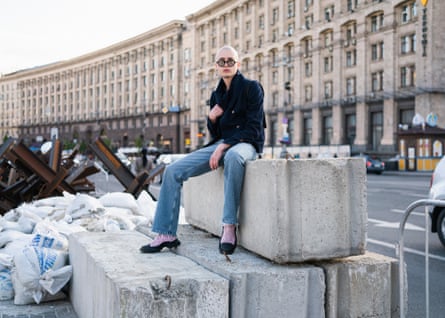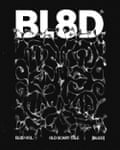[ad_1]
When 26-year-old documentary photographer Sebastian Wells travelled from Berlin to Ukraine shortly after the Russian invasion, he wasn’t entirely sure what he was going to do. “Many of my colleagues went directly to the frontline,” he explains from a sunny cafe in Kyiv. “I knew that wouldn’t be my role, but I didn’t know what else I should do. I spent two weeks in Kyiv getting frustrated and feeling like some kind of war tourist, and that’s when I started trying to find young creative people in the city.”
His first meeting was with 22-year-old fashion photographer Vsevolod Kazarin, and together the pair set about taking pictures of young people on the streets of Kyiv. Sharing a camera and an SD card, they assembled a series of street-style images, with their subjects photographed alongside sandbags, concrete barricades and anti-tank obstacles.
They thought they could maybe use their images to create propaganda posters that they could send to friends in European cities, building bridges with young people across the EU and encouraging them to donate to Ukraine.
But then they came across illustrations by the 18-year-old artist Sonya Marian that rework Soviet-era Russian paintings to explore the origins of Russian aggression. They read the text that Andrii Ushytskyi, 22, posted to his Instagram account, reflecting on his personal experiences of the war – and as the texts and imagery came together, they realised they had something much more substantial than a series of posters.
The first issue of Solomiya was published in August 2022 as a big, beautiful and defiant piece of print, with the second issue printed last month. It has come a long way from the early idea of posters but the mission has stayed the same. Reading Solomiya gives an intimate account of what life is like for young people in Kyiv. It also makes it easy for readers to send support – the magazine gives details of charities and organisations run by young Ukrainians alongside QR codes for donating to them.
Another magazine on its second issue is Telegraf, which was first published in May 2021 as a journal for the Ukrainian design community. The second issue was initially focused on Ukrainian digital product design and was nearing completion when Russia invaded. Priorities suddenly shifted.
after newsletter promotion
“From the first days of the full-scale invasion we have seen a huge surge of activity by designers, illustrators, artists and all other creatives,” says editor-in-chief Anna Karnauh. “These artworks have become a huge inspiration for many Ukrainians. We realised that we simply had to collect them and to tell the real story of how creatives lived and worked during this war.”
Now on its third print run, Telegraf’s war issue is a remarkable object, with each cover customised by hand and slogans printed on the fore-edges of the pages so that either “Slava Ukraini!” (Glory to Ukraine) or “Heroiam Slava” (Glory to the heroes) appears on the edge of the magazine depending on which way it’s held. It is only available in Ukrainian so far, but an English version will be published in the coming months, and Karnauh and her team hope to reach a wider audience with it.
The war has inspired magazine-makers on the Russian side, too – BL8D (pronounced “blood”) is published by a group of Russian artists and creatives who oppose Vladimir Putin’s regime, and, like Telegraf, it resulted from a sudden change of plan. Originally intended as a trendbook that searched for the essence of Russian culture, the project was ready to print when Russia invaded. The team responded by scrapping their PDFs and setting to work on an anti-military manifesto, condemning the war and looking forward to a day after Putin’s regime has been toppled.
The magazine is based on two long interviews probing deep into Russian identity – one with art historian Tata Gutmacher and one with museum researcher Denis Danilov. The interviews are presented alongside photography and illustration that create a stark and striking picture of “Russianness” and argue that a different reality is possible.
“The entire Putin regime rests on the myth that Europe hates Russia and nothing good awaits a person outside,” says creative director and editor-in-chief Maria Azovtseva. “We decided to create our own weapon – an art book about the imminent death of the Putin myth.”
Art and soul: images from the new magazines


Solomiya
“If we were to describe life in times of war, we would use the word ‘but’, because it evokes a feeling of discomfort and ambiguity that emerges when discussing something that is far beyond our control. Ukrainians have to keep living, but must also remember that death may come at any second.” Taken from editor’s letter.

BL8D
“[The magazine is] our voice against the war. It is our anger and our rage towards those who started this war, and those who still support it … It is our fears and an attempt to look at ourselves in the mirror to understand how this could have happened to all of us.” Taken from editor’s letter.


Telegraf
“We have collected iconic images that arose during the full-scale war,” says editor Anna Karnauh, ”together with personal stories of people who lived in and fled out of the occupation, who instead of working in the office or sipping oat lattes on the way to design meetups, are now defending their country on the frontline.”
Steven Watson is the founder of stackmagazines.com
[ad_2]
#created #weapon #antiinvasion #magazines #defying #Putin #Ukraine
( With inputs from : www.theguardian.com )

Leave a Reply